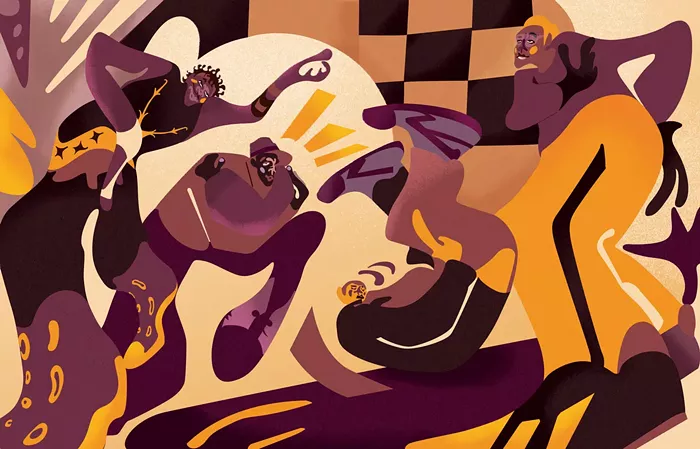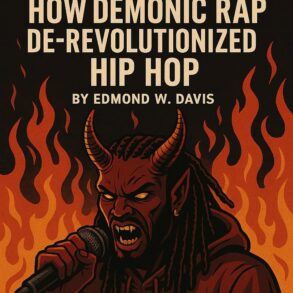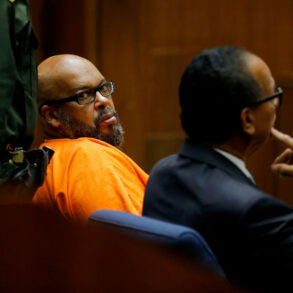Illustrations by Naomi Likayi
We live in a time where cruelty has become the dominant passion. How do we, to use the words of Hole, “live through this”? By, for one, countering cruelty with a passion that has been central to Black culture, dancing: the passion of joy.
More to the point, dancing is one of the four original elements of hip-hop. In fact, between the show-stealing Rock Steady Crew scene from the movie Flashdance, the studio-backed films Beat Street, Breakin’, and Breakin’ II: Electric Boogaloo, and a starring role in the closing ceremony of 1984 Olympic Games in Los Angeles, it could be argued that dance was the most prominent part of this culture during the early 1980s. But as the decade came to a close, dance fell into the background as rap surged in popularity and profitability. Lines like “but I don’t party and shake my butt” from Ice Cube’s 1990 song “Jackin’ for Beats,” and singles such as 1998’s “They Don’t Dance No Mo’” by Goodie Mob confirmed this demotion.
But all is not lost. The joy of dancing is still with us. The undeniable drums and irresistible basslines have protected and preserved the dance space within hip-hop over the decades. What we present in this article is a very small sample of the moves, the styles, and the forms of butt-shaking that captured the world’s imagination.
THE DANCE: Uprock
THE KEY MOVE: Shuffling of feet (sometimes forward; sometimes backward) as arms swing rhythmically from side to side. The best uprocking never looks sturdy, but instead looks as if the dancer is about to collapse, yet is somehow defying the pull of this collapse.
THE TRACK: “Apache” by Incredible Bongo Band
[embedded content]
“Apache” was originally recorded by the UK group the Shadows in 1960, but Incredible Bongo Band’s much funkier 1973 version became one of the most sampled tracks in music history. In the 1980s it became synonymous with hip-hop after being sampled by the likes of Grandmaster Flash (“Grandmaster, cut faster”) and the Sugarhill Gang (“Tonto, jump on it, jump on it, jump on it”). For many, “Apache” became the ultimate uprock song. Here, we must point out that uprocking—the standing moves of breakdance—mostly consisted of styles developed around the time “Apache” was dropped. Watch any line dance section of Soul Train in 1973 and you will see forms of this dance: popping, locking, the Robot, the Moonwalk. And we must not forget that Freddie “Rerun” Stubbs (Fred Berry) brought uprocking to the mainstream in the sitcom What’s Happening!! (1976–1979). By the early ’80s, these moves, and more, were a part of a collection of dances consolidated by breakdancers in NYC. It is, however, with great shame that, during the 2024 Paris Olympics, the Australian b-girl Rachel Gunn gave a kangaroo-looking interpretation to stand dancing. Thankfully, Rerun didn’t live long enough to see Raygun.
THE DANCE: The Pee-Wee Herman
THE KEY MOVE: Stand on your toes, bend knees slightly, and, with jerky motions, move backward and forward.
THE TRACK: “Pee-Wee’s Dance” by Joeski Love
[embedded content]
The comedy of Paul Reubens was not for everyone. However, it was for enough people to get two Pee-wee Herman movies and an Emmy-winning children’s television series made. The famous scene from Pee-wee’s Big Adventure with Pee-wee dancing on a bar to the song “Tequila” by the Champs made its way further into hip-hop culture thanks to Joeski Love’s slamming 1986 single “Pee-Wee’s Dance.”
THE DANCE: Seattle’s Square Dance
THE KEY MOVE: Basically, square dance as directed and imagined by Sir Mix-a-Lot.
THE TRACK: “Square Dance Rap” by Sir Mix-a-Lot
[embedded content]
In 1988, Seattle’s defining rapper, Sir Mix-a-Lot, presented to the world the Central District’s version of square dancing. Explaining the track has proved far easier than explaining the dance. “Square Dance Rap” combined two early hip-hop trends. One was the use of a voice modulator that gives a sound à la “Pappa Smerf (The Big Throw Down)” by Electric Power Band. This use of technology gave more of a Chipmunks sound than the Auto-Tune style so common in rap today. Another dynamic was the eclectic inclusion of elements of other music or cultures. But, and here is the rub: How do you do it? Here we admit complete ignorance and refer you to the description provided by Mix-a-Lot in these lines:
If you can’t dance, I’ll tell you how
Wave your hands and take two steps
Grab your hips and slide to the left
Get all in your partner’s face
Swerve to the side and show your lace
If you’re a freak then let it show
And grab your partner doshy-do (do, do)

THE DANCE: The Fly Girl
THE KEY MOVE: Flexed arms that are shaken vigorously as you hop and turn, hop and turn.
THE TRACK: “Ladies First” by Queen Latifah
[embedded content]
Given all she has done, it can be easy to forget that Queen Latifah’s varied and dynamic career began as a member of the Native Tongues collective (Jungle Brothers, De La Soul, A Tribe Called Quest, Monie Love). In those early times, Latifah’s videos and performances featured the dancing of Allison Ashmawy and Kika Martin, aka the Safari Sisters. (Gone are the days when rappers had designated dancers.) In an era before bare cheeks and twerking, the Safari Sisters brought righteous flavor to the still evolving environment of video presentation and live shows. (We have no problem with twerking, it’s just that we want dance moves to be more democratic, more open, more mixed up.) The Safari Sisters were Afrocentric, rebellious, and fly. Indeed, the Fly Girl, as a dance and attitude, gave Jennifer Lopez her start on the show In Living Color, and it spectacularly opened Spike Lee’s 1989 movie Do the Right Thing. The Sarafi Sisters made the Fly Girl a rebel with a cause.
THE DANCE: The Kick Step
THE KEY MOVE: The key to this dance—which involves a half-kick forward, followed by returning the leg to the ground with a backward foot slip/slide—is maintaining a regular bounce to the beat.
THE TRACK: “Gittin’ Funky” by Kid ’n Play
[embedded content]
As the 1980s came to a close, different styles and energies began to define what would become known as the “Golden Era of Rap.” However, these styles did not always peacefully coexist. Artists who lean more to the hardcore side would sometimes criticize those who embraced a more fun and poppy stylistic approach. Kid ’n Play wholeheartedly represented the latter. Their video for “Gittin’ Funky” introduced Air Jordans as dance shoes and gave us the Kid ’n Play Kick Step and the iconic running man. The latter ruled the late ’80s and early ’90s and can be described as the “Red Queen race” (running without moving).
THE DANCE: Get Busy in a Burger King Bathroom
THE KEY MOVE: Humping (“It’s supposed to look like a fit or a convulsion”).
THE TRACK: “The Humpty Dance” by Digital Underground
[embedded content]
On top of their highly original music and style, Digital Underground, in 1990, also promoted a new dance described by MC Shock G’s wild alter ego Humpty Hump. The song features an incredible looping bassline along with a perceived dig at a fellow Bay Area artist— “People say, ‘You look like MC Hammer on crack, Humpty.’” Also, before going full-on gangster with Suge Knight and Death Row Records, Tupac Shakur’s early affiliation with Digital Underground included him performing the Humpty Dance during live appearances, the most notorious of which was on The Arsenio Hall Show.

THE DANCE: Hammerdance
THE KEY MOVE: Shuffling from side to side with legs that are apart and slightly bent; roll the shoulders as you shuffle.
THE TRACK: “U Can’t Touch This” by MC Hammer
In the annals of music history, Hammer is often reduced to a caricature, if not left out completely. The truth is that he was at the forefront of a massive shift in hip-hop culture during the late 1980s. In 1988, Hammer released his second album, Let’s Get It Started. Two videos, “Pump It Up” and “Turn This Mutha Out,” did a couple of things. First, they broke wide open the discussion of what was considered hip-hop dance at that point. Remember, this was only four years after breaking and popping and locking were stars of the seminal hip-hop films Beat Street and Breakin’. Hammer’s groundbreaking choreography, backed by Oaktown’s 3.5.7, completely revolutionized not only dance within hip-hop, but in other genres as well. Secondly, these videos turned out to be early (and lesser recognized) shots from a West Coast artist toward the East. “Pump It Up” shows Hammer snatching a microphone from three men who clearly represent Run-DMC; “Turn This Mutha Out” features a newspaper headline that says “Hammer Takes On New York” and finds him openly challenging a big-shot New Yorker during a provocative performance in a club.

THE DANCE: Crip Walk
THE KEY MOVE: Intricately move feet and ankles as arms are raised in a suspended manner, almost to the chin.
THE TRACK: “C-Walk” by Kurupt
[embedded content]
The West Coast’s most identifiable move is without a doubt the Crip Walk, which has roots in the 1970s and was, of course, associated with the Crips. In fact, the dance steps for C Walking supposedly spell the word “Crips.” In 1998, hip-hop appropriated the gang-based dance by way of Kurupt’s 1998 hit track “C-Walk.” This year, the whole world watched tennis superstar Serena Williams Crip Walk during Kendrick Lamar’s Super Bowl halftime performance. And what makes this dance so striking? It’s all about footwork. The feet are the stars of this move. The body is chill and even amazed by what the feet are doing: so complicated, so precise, so smooth, so intricate. We believe that human feet are big fans of the C-Walk.
THE DANCE: East Coast Stomp
THE KEY MOVE: Seize/crunch the body as if you are having a stomachache full of beats as
you step with a pop (stomp) and throw arms out alternately.
THE TRACK: “Scenario” by A Tribe Called Quest (featuring Leaders of the New School)
[embedded content]
The notion of regional dance emerged within hip-hop in the 1990s. The West Coast had the Hammerdance and the Crip Walk, the East Coast had the Stomp made famous by A Tribe Called Quest, Leaders of the New School, Black Moon, and the like. The East Coast Stomp is not at all expressive like the Hammerdance or the Fly Girl. The dancer instead stunts the run, stunts the hands, and shakes like the boom bap has got a grip of their soul. Hammerdance goes outward; the East Coast Stomp goes inward.
THE DANCE: The Professor
THE KEY MOVE: Half-step with a dignified, forward lean as arms alternately swing toward chest.
THE TRACK: “Not Like Us” by Kendrick Lamar
[embedded content]
We know it’s not fair to give all the credit for this new hip-hop dance to the literary theorist and Harvard historian Henry Louis Gates Jr., but no one busts it like he did to Kendrick Lamar’s “Not Like Us.” Watch it on Instagram. Gates has it down, and he even described the move as “a deep dive into family history.” And so it is. We must identify this dance. We call it: The Professor. The Professor requires that you look funky, proud, and snobby at once.
THE DANCE: Booty Bounce
THE KEY MOVE: Crouch and bounce that thing God gave you.
THE TRACK: “Anaconda” By Nicki Minaj
[embedded content]
Nicki Minaj is a descendant of the 1990s, when women in rap began to openly wrestle with ideas of sexual empowerment versus sexual exploitation in new ways. The days of MC Lyte wearing creased jeans and a turtleneck (see the video for “Paper Thin”) had been swept away. Now, the famous sample from “Baby Got Back” was synchronized with booty bounces. Scholar Imani Perry argued, “Black American dance is discursive in that sexuality is usually combined with humor, and that the body is used to converse with other moving bodies.” In this decade, the TikTok sensation Doechii made it clear in her “Booty Drop” that strip-club culture was definitely in this house.
THE DANCE: The Lean Back
THE KEY MOVE: Just lean back.
THE TRACK: “Lean Back” By Fat Joe
[embedded content]
Fat Joe put it like this: “…my niggas don’t dance / we just pull up our pants, and do the Rockaway, now lean back.” So, again, with this move, you actually don’t dance; you just lean back.
Bust a Move: The History of Dance Styles in Hip-Hop with Charles Mudede, Professor Daudi Abe, and DJ Vitamin D, Wed May 14, the Royal Room, 8 pm, $12/$15, all ages until 10 pm.
This post was originally published on this site be sure to check out more of their content.







